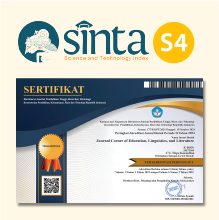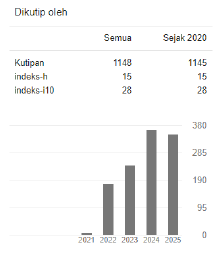Analysis of Learning Styles Based on Indonesian Language Learning Outcomes in Elementary School Students
 https://doi.org/10.54012/jcell.v4i2.346
https://doi.org/10.54012/jcell.v4i2.346
 Abstract views: 306
Abstract views: 306
 PDF downloads: 240
PDF downloads: 240
Keywords:
effective learning, elementary school students, Indonesian language, learning outcomes, learning stylesAbstract
Understanding students' learning styles is a key factor in effective learning, as it helps teachers optimize the teaching and learning process and improve student success. This study aims to examine the relationship between students' learning styles and learning outcomes in the Indonesian language subject. The research uses a survey method with a sample of 46 fifth-grade elementary school students using saturated sampling techniques. The results indicate that the majority of students have a kinesthetic learning style (43.5%), followed by visual learning styles (30.4%) and auditory styles (26.1%). The learning outcomes of visual learners are higher compared to the others, with an average score of 84.3 in the good category, while auditory learners perform better than kinesthetic learners but lower than visual learners, with an average score of 81.4 in the fair category, whereas kinesthetic learners have lower results compared to the others, with an average score of 79.5 in the fair category. This suggests that a teaching process that does not consider the diversity of learning styles can negatively impact students' learning outcomes. Therefore, teachers need to pay attention to students' learning styles to enhance learning effectiveness so that students' learning outcomes can be optimal.
Downloads
References
Astuti, M., Sofyan, F. A., & Marisa, M. (2019). Hubungan antara learning style dengan hasil belajar siswa pada mata pelajaran matematika kelas V di MIN 2 Palembang. JRPD (Jurnal Riset Pendidikan Dasar), 2(1), 54–65. https://doi.org/10.26618/jrpd.v2i1.2062
Creswell, J. W. (2015). Educational research, planning, conducting and evaluating: qualitative and quantitative research. Boston: Pearson.
DePorter, B., & Hernacki, M. (2016). Quantum learning membiasakan belajar nyaman dan menyenangkan. Bandung: Kaifa.
Irawati, I., Ilhamdi, M. L., & Nasruddin, N. (2021). Pengaruh gaya belajar terhadap hasil belajar IPA. Jurnal Pijar Mipa, 16(1), 44–48. https://doi.org/10.29303/jpm.v16i1.2202
Kamboj, P., & Singh, S. K. (2015). Effectiveness of select teaching strategies in relation on the learning style of secondary school student in India. Interchange, 46(3), 289–312.
Khoeron, I. R., Sumarna, N., & Permana, T. (2016). Pengaruh gaya belajar terhadap prestasi belajar peserta didik pada mata pelajaran produktif. Journal of Mechanical Engineering Education, 1(2), 291. https://doi.org/10.17509/jmee.v1i2.3816
May, T. . (2005). Teaching maths to pupils with different learning styles. London: Paul Chapman Publishing.
Menik, K., & Yuhendri, L. (2016). Analysis characteristics of learning styles VAK (Visual, Auditory, Kinesthetic) student of Banks and Financial Institutions course. International Conference on Education for Economics, Business, and Finance, 437–446.
Putri, N. W. S., & Suryati, N. K. (2020). Analysis of the style of learning based on visual, auditorial, kinesthetic on students of computer system. IJECA (International Journal of Education and Curriculum Application), 3(1), 43. https://doi.org/10.31764/ijeca.v3i1.2056
Rosdiana, M. P. M., Muslimin, M., & Firmansyah, F. (2022). The use of visual, auditory, kinesthetic (VAK) learning to increase student learning outcomes. Inornatus: Biology Education Journal, 2(2), 85–93. https://doi.org/10.30862/inornatus.v2i2.343
Supit, D., Melianti, M., Lasut, E. M. M., & Tumbel, N. J. (2023). Gaya belajar visual, auditori, kinestetik terhadap hasil belajar siswa. Journal on Education, 5(3), 6994–7003. https://doi.org/10.31004/joe.v5i3.1487
Tulbure, C. (2012). Investigating the relationships between teaching strategies and learning styles in higher education. Acta Didactica Napocensia, 5(1), 65–74.
Downloads
Published
How to Cite
Issue
Section
License
Copyright (c) 2024 Rini Purbayani, Anggi Purwa Nugraha, Nabila Nurhaliza Ali

This work is licensed under a Creative Commons Attribution-ShareAlike 4.0 International License.
All articles published in the Journal Corner of Education, Linguistics, and Literature are licensed under the Creative Commons Attribution-ShareAlike License (CC BY-SA).

















